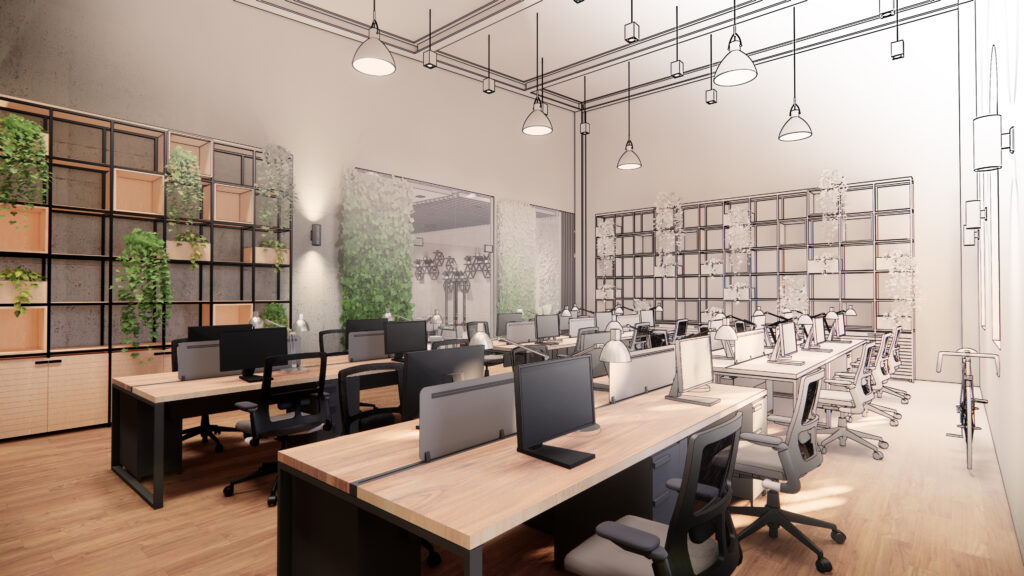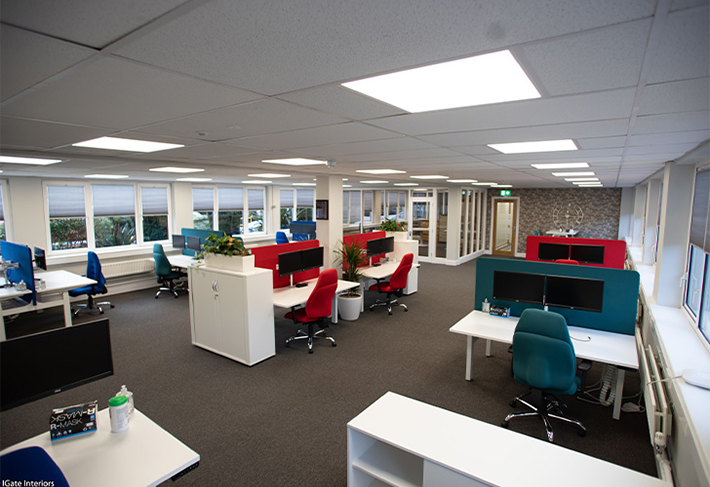Commercial office design in 2025 will prioritise adaptability, employee well-being, and sustainability. Multi-functional spaces will transition between collaborative and focused work, while biophilic elements and smart technology enhance comfort and efficiency.
The brand-driven design will showcase company values and strengthen organisational culture. Modular furniture and optimised layouts will boost productivity in minimal square footage. Embracing these innovative design principles will help businesses succeed in the evolving landscape of commercial office spaces.
Key Takeaways
- Flexible workspaces with adaptable furniture and layouts to support hybrid work models and collaboration
- Biophilic design incorporating natural elements such as plants, natural light, and organic materials for employee well-being
- Technology integration, including smart lighting, climate control, and advanced collaboration tools for efficiency and sustainability
- Customised brand-driven design showcasing company values through colour, materials, and decor
- Space optimisation with multi-functional furniture, modular storage, and vertical solutions to enhance efficiency
How Office Design Impacts Business Success
The impact of office design on business success is significant, shaping productivity, creativity, and employee well-being. Modern office designs focus on employee wellness, incorporating ergonomic furniture, biophilic elements, and collaborative spaces to enhance efficiency.
Studies indicate that well-designed workspaces can boost productivity by up to 20%, contributing to overall business growth.
Reimagining Office Layouts
Modern office layouts embrace multi-zone workspaces that cater to both collaboration and focused work, striking a balance between open plans and private spaces:
Multi-Zone Workspaces for Collaboration and Focus
Embracing the evolving nature of work, multi-zone workspaces have emerged as a groundbreaking solution to the diverse needs of modern employees.
Integrating collaboration zones and quiet spaces for focused work, these adaptable layouts promote seamless transitions between tasks.
Open Plans vs. Private Spaces: Striking a Balance
Open layouts foster collaboration and teamwork, while private spaces provide essential environments for focused work and confidential discussions. A well-balanced layout improves employee satisfaction and productivity.
- Create spaces that inspire both collaboration and concentration
- Empower employees with flexible work environments
- Unlock workforce potential through thoughtful spatial planning
Designing for Hybrid Workforces
The rise of hybrid workforces has driven a shift in office design, requiring adaptable layouts that support both remote and in-office employees.
Task-based zones, dedicated Zoom rooms, and modular workspaces enable seamless transitions between individual work and collaboration.
The integration of smart technology allows real-time adjustments, promoting comfort and efficiency in hybrid working environments.
Designing for Employee Wellbeing
Prioritising employee well-being involves incorporating relaxation zones, quiet areas, and ergonomic furniture to enhance mental and physical health.
Incorporating Relaxation Zones
Designing for employee well-being has become a crucial aspect of modern office design. Dedicated relaxation zones reduce stress and boost productivity, fostering collaboration and creativity through informal interactions.
Companies that prioritise employee well-being benefit from:
- Increased job satisfaction and retention
- Improved mental health and mindfulness
- Stronger team dynamics and innovative ideas
- Improved work-life balance and overall happiness
Creating Quiet Areas for Mental Health Breaks
In today’s fast-paced work environment, creating quiet areas for mental health breaks has become an essential aspect of office design that prioritises employee wellbeing.
Quiet areas, including wellness rooms and meditation spaces, help employees recharge and improve productivity. Research from the National Institute for Occupational Safety and Health (NIOSH) also shows that regular use of wellness rooms is linked to a 32% increase in productivity.
Biophilic design elements like plants and natural light further enhance the calming effect of these multi-purpose quiet zones.
Ergonomic Furniture as a Non-Negotiable
Ergonomic furniture is essential for employee comfort and well-being.
Adjustable desks and supportive/soft seating reduce strain and create a healthier work environment.
Investing in ergonomic solutions reflects a commitment to employee health, boosting morale and productivity.
Brand-Driven Office Design
Incorporating brand identity into office design is a powerful way to showcase company values and foster a strong organizational culture:
Showcasing Company Values Through Design
Showcasing company values through brand-driven office design has become an increasingly important aspect of creating inspiring and engaging workplaces.
A well-designed office that aligns with a company’s mission and culture can:
- Foster a sense of belonging and pride among employees
- Enhance employee well-being and productivity through flexible and inclusive layouts
- Demonstrate commitment to sustainability with eco-friendly materials and energy-efficient systems
- Reinforce brand identity and values, creating a cohesive and impactful workspace
Customising Furniture and Decor to Reflect Your Brand
When creating a brand-driven office design, customizing furniture and decor to reflect the company’s identity is essential for fostering a cohesive and engaging workspace.
Modular furniture with unique designs or brand-centric motifs can enhance employee engagement, while art and decor that tell the company’s story create emotional connections.
Well-designed branded environments improve employee satisfaction by up to 20%, showcasing the importance of customising furniture.
Using Colour Psychology to Match Your Mission
Colour psychology, a powerful tool in brand-driven office design, goes beyond mere aesthetics to create workspaces that embody a company’s mission and values.
Strategically incorporating brand colours and biophilic elements can:
- Enhance brand recognition and identity
- Evoke specific emotions to boost productivity and collaboration
- Foster a balanced, inspiring atmosphere that resonates with employees
- Demonstrate the company’s commitment to sustainability and well-being
Learn More on This: The Importance of Colour in The Workplace
Integrating Sustainability in Office Design

Integrating sustainability into office design has become increasingly important as businesses recognise their environmental responsibility. Eco-friendly materials, such as reclaimed wood, bamboo, and recycled plastics, significantly reduce the environmental impact while promoting energy efficiency and healthier work environments.
Sustainable furniture and flooring choices demonstrate a commitment to sustainability, contributing to forest conservation efforts and unique aesthetic qualities.
Energy-Efficient Lighting and Climate Control
Embracing energy-efficient lighting and climate control technologies is crucial for creating sustainable office environments that prioritise both environmental responsibility and employee well-being.
LED fixtures and smart climate control systems optimise energy consumption, while bioclimatic design principles harness natural ventilation and daylighting.
Integrating renewable energy sources and energy-efficient materials further enhances sustainability, resulting in reduced operational costs and a minimised carbon footprint.
Recycling and Waste Management Stations
Beyond energy-efficient lighting and climate control, the incorporation of well-designed recycling and waste management stations is a key element in creating sustainable office environments.
Strategically placed stations with clear signage and colour-coded bins promote proper waste sorting, reducing landfill contributions. Smart technology integration provides real-time data, enhancing sustainability efforts and fostering employee engagement in eco-friendly practices.
Biophilic Design: Bringing Nature Indoors
Biophilic design, which brings nature into the office environment, has gained popularity in recent years due to its numerous benefits for employee well-being and productivity.
Adding Greenery with Plants and Living Walls
One of the most effective ways to create a calming and inspiring office environment is by incorporating plants and living walls into the design.
Adding greenery through biophilic design principles not only enhances employee well-being but also contributes to sustainability goals.
The presence of natural elements in the workspace offers numerous benefits:
- Reduced stress levels and improved mental health
- Increased productivity and creativity
- Cleaner air quality and a healthier work environment
- Aesthetic appeal that reflects corporate values
Maximising Natural Light for Productivity
In addition to integrating plants and living walls, maximizing natural light is another crucial aspect of biophilic design that can significantly enhance productivity in the workplace.
Large windows and open layouts allow sunlight to flood the office space, reducing eyestrain and fostering an energizing environment.
Using Natural Materials to Create a Calming Atmosphere
Incorporating natural materials into office design has become an increasingly popular trend, as businesses recognise the importance of creating a calming and harmonious work environment.
By integrating elements such as wood, stone, and living walls, companies can enhance employee well-being and foster a deeper connection with nature.
Biophilic design principles suggest that these features can:
- Boost productivity and creativity by up to 15%
- Reduce stress levels and promote a sense of tranquillity
- Improve employee satisfaction and retention
- Reflect a commitment to sustainability and wellness
Technology-Enabled Workspaces
Technology-enabled workspaces are revolutionizing the modern office landscape.
As businesses embrace the digital age, commercial office designs are integrating:
Smart Tech for Lighting, Climate, and Security
As the world of work evolves, modern offices are embracing technology-enabled workspaces that seamlessly integrate smart systems for lighting, climate control, and security.
These innovative solutions not only enhance user comfort and efficiency but also significantly reduce energy consumption.
Smart tech in the office environment includes:
- Intuitive lighting and temperature controls that adapt to occupancy and natural light levels
- Advanced security systems with automated access controls and occupancy sensors
- AI-driven systems that analyse usage patterns and make real-time layout adjustments
- Seamless integration of IoT-enabled devices for a truly connected workspace experience
Integrated Collaboration Tools for Teams
Beyond the realm of smart lighting and climate control, modern offices are embracing integrated collaboration tools that revolutionise the way teams work together in technology-enabled workspaces.
Augmented reality, virtual reality, and interactive displays facilitate immersive brainstorming sessions and seamless document sharing.
Advanced video conferencing tools with high-definition cameras and professional-grade audio maintain clear communication among remote team members, enhancing productivity and collaboration.
Designing for Future Tech Upgrades
In the rapidly evolving landscape of modern offices, designers must anticipate and accommodate the integration of future technologies to create workspaces that remain adaptable and efficient.
Technology-enabled workspaces will leverage smart furniture, data-driven design, and advanced tools to support hybrid teams.
Future-proof office designs will prioritise:
- Seamless connectivity for enhanced collaboration
- Responsive environments that adapt to changing needs
- Intuitive interfaces for effortless control
- Sustainable solutions that optimise resource usage
Office Design for Small Commercial Spaces
When designing small commercial office spaces, investing in space-saving furniture is essential to maximise the available square footage:
Space-Saving Furniture Ideas
Designing a functional and aesthetically pleasing office within a limited space can be challenging, but the innovative use of space-saving furniture offers a solution.
Modular desks, foldable tables, and multi-functional pieces allow for flexible configurations, while ergonomic, compact workstations ensure comfort without sacrificing valuable space.
Vertical storage solutions and lightweight, movable furniture further optimise the area, creating an efficient and adaptable work environment.
Creative Storage Solutions for Tight Spaces
Maximizing space and maintaining organization in small commercial offices can be a daunting task, but creative storage solutions offer a way to optimise even the tightest of spaces.
Utilizing vertical storage, incorporating multi-functional furniture, and implementing modular storage systems are innovative design elements that enhance functionality and aesthetics.
Designating storage zones and employing clear storage solutions further streamline the organisation, creating an efficient workspace.
Transformable Workstations for Multi-Use Areas
Transformable workstations are a game-changer for small commercial spaces, offering a dynamic solution to the challenges of limited square footage.
These adaptable furniture systems enable quick reconfiguration, seamlessly transitioning between collaborative areas and focused work zones.
With mobile desks and multi-use spaces, businesses can maximise their utility in a compact footprint, fostering a flexible and creative environment that supports diverse work styles.
Frequently Asked Questions
How Can Office Design Boost Productivity and Collaboration Among Employees?
Office design can boost productivity and collaboration by creating diverse spaces that facilitate different work styles, incorporating biophilic elements to reduce stress, and integrating intuitive technology to support efficient processes and interactive collaboration. IGate Interiors specialises in creating such innovative and efficient office designs.
What Are the Best Ways to Incorporate Company Branding Into Office Design?
While some may argue that branding can be superficial, thoughtfully incorporating company values and culture into office design can be powerful. Unique wall graphics, interactive spaces, and carefully selected materials authentically reflect the brand, engaging employees and visitors alike.
How Do You Create a Comfortable and Inviting Reception Area for Clients?
To create a comfortable and inviting reception area, designers should focus on warm lighting, comfortable seating, and welcoming decor. Incorporating natural elements, like plants or wood accents, can promote a calming atmosphere for waiting clients.
What Are the Most Important Factors to Consider When Designing a Home Office?
When designing a home office, prioritise ergonomic furniture for comfort, ample storage for organization, and adequate lighting for productivity. Consider incorporating personal touches and natural elements to create an inviting and inspiring workspace.
How Can Office Design Accommodate the Needs of a Multigenerational Workforce?
To accommodate a multigenerational workforce, office design should incorporate flexible spaces that cater to diverse working styles and preferences. Adaptable furniture, technology integration, and a balance of collaborative and private areas can foster inclusivity and productivity.
Conclusion
As businesses look towards 2025, the evolution of commercial office design will play a pivotal role in shaping the future of work. IGate Interiors highlights the importance of embracing innovative ideas that prioritise employee well-being, collaboration, and productivity. Companies can create inspiring and adaptable workspaces that not only support the needs of their workforce but also foster a strong company culture. The office of the future will be a testament to the power of design in driving business success.


